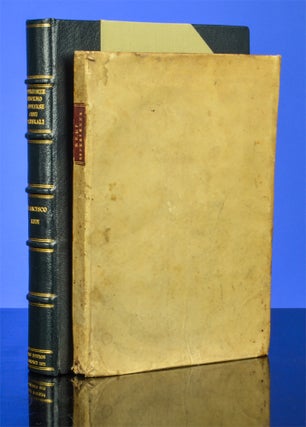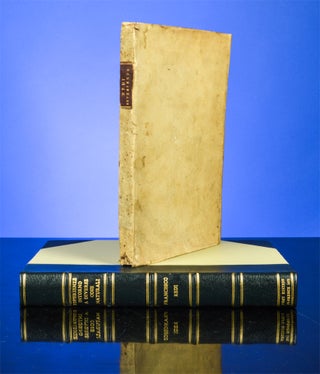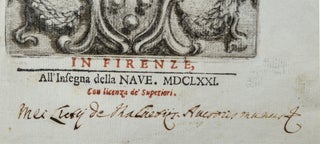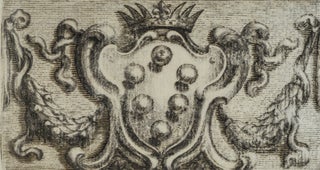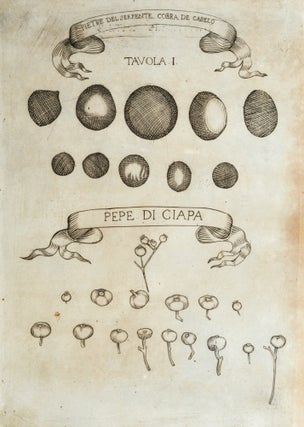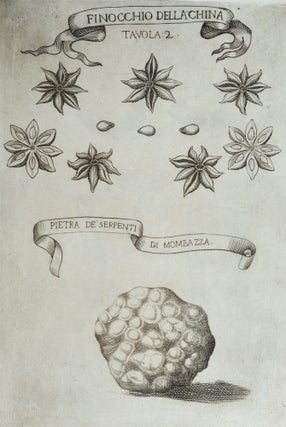Esperienze Intorno
Firenze: All'Insegna della Nave, 1671. Item #03222
Kircher's Nemesis Spurns His Claims Yet Again
One of Three Companions To Petrucci's Defense of Kircher
A Fine Presentation Copy From The Author
REDI, Francesco. Esperienze Intorno. A Diverse Cose Naturali, e Particularamente a Quelle, che ci son Portate dal Indie Fatte da Francesco Redi e Scritte in una Lettera al Reverendissimo Padre Atanasio Chircher della Compagnia di Gesu'. Firenze: All'Insegna della Nave, 1671.
First edition of this rare and important treatise by the famous Italian naturalist, addressed to his colleague Athanasius Kircher, which includes the first scientific test of nicotine and its harmful effects.
Quarto (9 7/16 x 6 7/8 inches; 240 x 175 mm).
Inscribed at the foot of the title-page "Mei [illegible] de Molinari. Auctorus munus" [i.e., gift of the author]; Early ink signature of the recipient, Giuseppe Molinari on front paste-down.
4(- 1), A-T4. [6], 152 pp (79 ff.) Title in red and black. Six engraved plates.
Contemporary vellum over boards, red leather lettering label on spine. Ink manuscript title on lower edge. Ink manuscript title on lower edge of text block. Housed in a fleece-lined half black morocco clamshell case.
Redi's "investigations of several botanical and zoological specimens, including some brought from India; among them were Chinese star anise, 'stones' from cobras and iguanas, vanilla beans, and a leaf from the chinchona tree. The treatise is in the form of a letter to to Athanasius Kircher" (Norman). "Raro" (Prandi).
Within is Redi's dismissal of Kircher’s claims for the miraculous curative qualities of the snake-stone [the "stones" that Norman refers to], a missionary artifact that allegedly sucked snake venom from a wound. Redi first dealt with this issue in his first work, Osservazioni intorno alle vipere (1664), "the first methodical study of snake venom" (Norman).
Redi's work was inspired by the arrival in Florence of medical and natural curiosities, some of which are illustrated in the six plates, which were brought back from the East and West Indies in 1662 by Franciscan missionaries
He enjoys a distinguished place in the canonical histories of biology on the grounds of his experiments aimed at discrediting the idea of spontaneous generation, which were reunited in his Esperienze intorno alla generazione degl'insetti (1668). In that work Redi explicitly set himself against Athanasius Kircher. The German Jesuit had defended the idea of spontaneous generation by putrefaction which he discussed… in his Archa Noë and also in in his Mundus Subterraneus" (de Asua & French, A New World of Animals, p. 210).
In return for these slaps to his reputation, "Kircher had his fellow Jesuit and disciple Gioseffo Petrucci publish the Prodromo apologetico alli studi Chircheriana (Apologetic Forerunner to Kircherian Studies) in 1677. Attacking the ‘envious and strident ignorance of his unjust accusers,’ Petrucci painted a portrait of Kircher as he wanted to be remembered: a judicious experimenter who carefully weighed all the evidence before coming to any conclusions. Emphasizing Kircher’s skepticism about natural phenomena, Petrucci countered the image of is master as a gullible consumer of tall tales about strange things by presenting him as the logical heir to Galileo. Citing Kircher’s unparalleled knowledge of non-European nature, he quoted Augustine as a cautionary tale for disbelieving readers: ‘Some credible things are false, just as some incredible things are true.’ Petrucci invited readers to examine Kircher’s own words in order to see the distortion that occurred in the characterization of his master in the words of critics. He promised to remove anything from his Prodromo Apologetica that readers found to be false" (Findlen, The Last Man To Know Everything, p. 39). Yet there is no evidence that Petrucci removed his defense of Kircher's snake-stones in the aftermath of this biting critique, nor of spontaneous generation.
Curiously, however, Kircher and Redi exchanged correspondence expressing mutual admiration, as noted in Fletcher's paper, Medical Men in the Correspondence of Athanasius Kircher (Janus LVI, 4. 1969). Epistolary courtesy was customary amongst seventeenth century scientists who, though they might be in sharp disagreement, needed to remain on cordial terms to allow the free exchange of information to remain uninterrupted.
Francesco Redi (1626-1698) was an Italian naturalist, physician, poet, and scientist - he "was one of the first parasitologists" (Norman). "After taking his degree in medicine, he entered the service of the Colonna family at Rome as a tutor, and held the position five years. In 1654 he went to Florence, where he acted as physician to the Grand dukes Ferdinand II and Cosimo III. He was constantly engaged in experiments intended to improve the practice of medicine and surgery, and yet found leisure for much literary work. He was an active member of several of the academies of the time, and, as an associate of the Crusca, aided in preparing its important Vocabolario. He taught in the Studio at Florence in 1666, as lettore publico di lingua toscana and was one of the first members of the Arcadia. His writings include a number of scientific documents, e.g. 'Osservazioni intorno alle vipere.' 'Esperienze intorno alla generazione degl' insetti,' 'Consulti medici,' etc." (Catholic Encyclopedia).
Norman 1518. Prandi 26. Sabin 68516. Gamba 823.
Price: $3,500.00

 I have been in the rare and antiquarian book business for over forty years; my family has been in the rare books business since 1876. Rare books are in my blood.
I have been in the rare and antiquarian book business for over forty years; my family has been in the rare books business since 1876. Rare books are in my blood.

